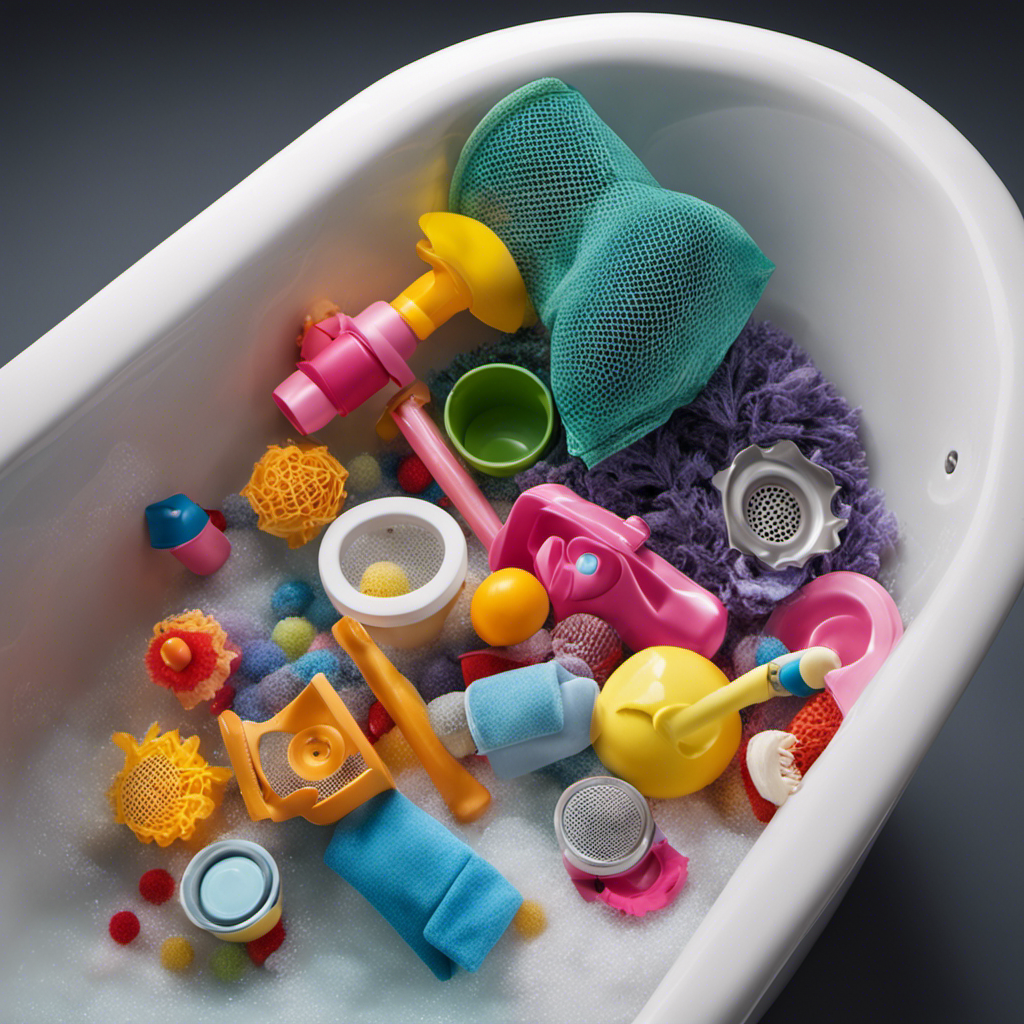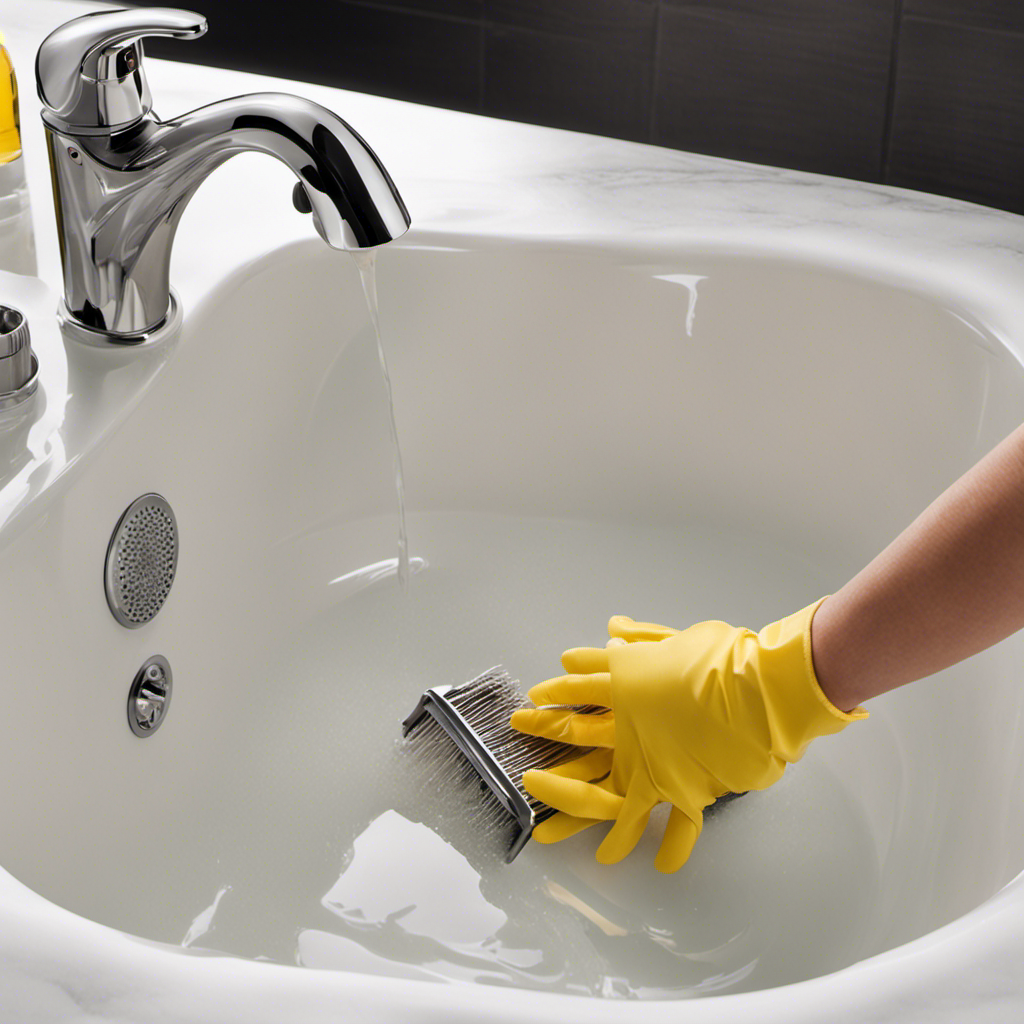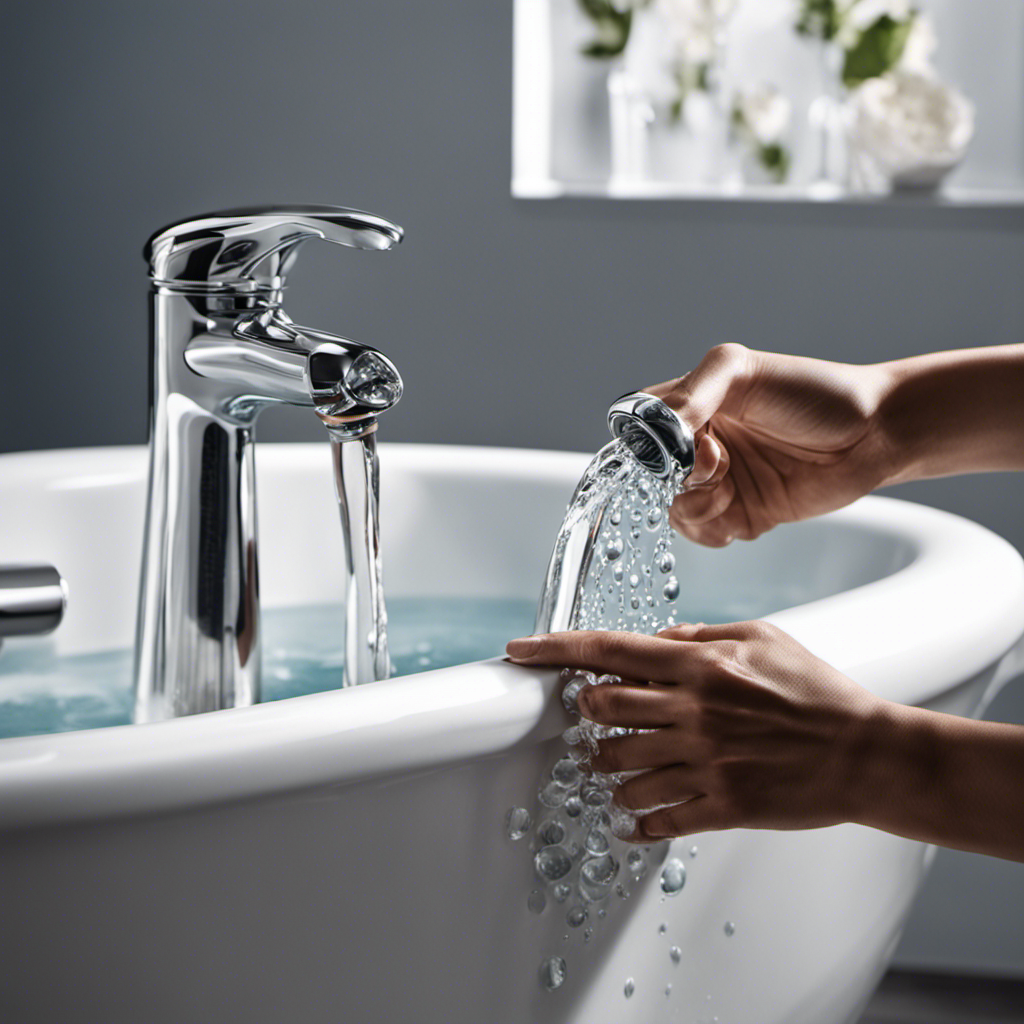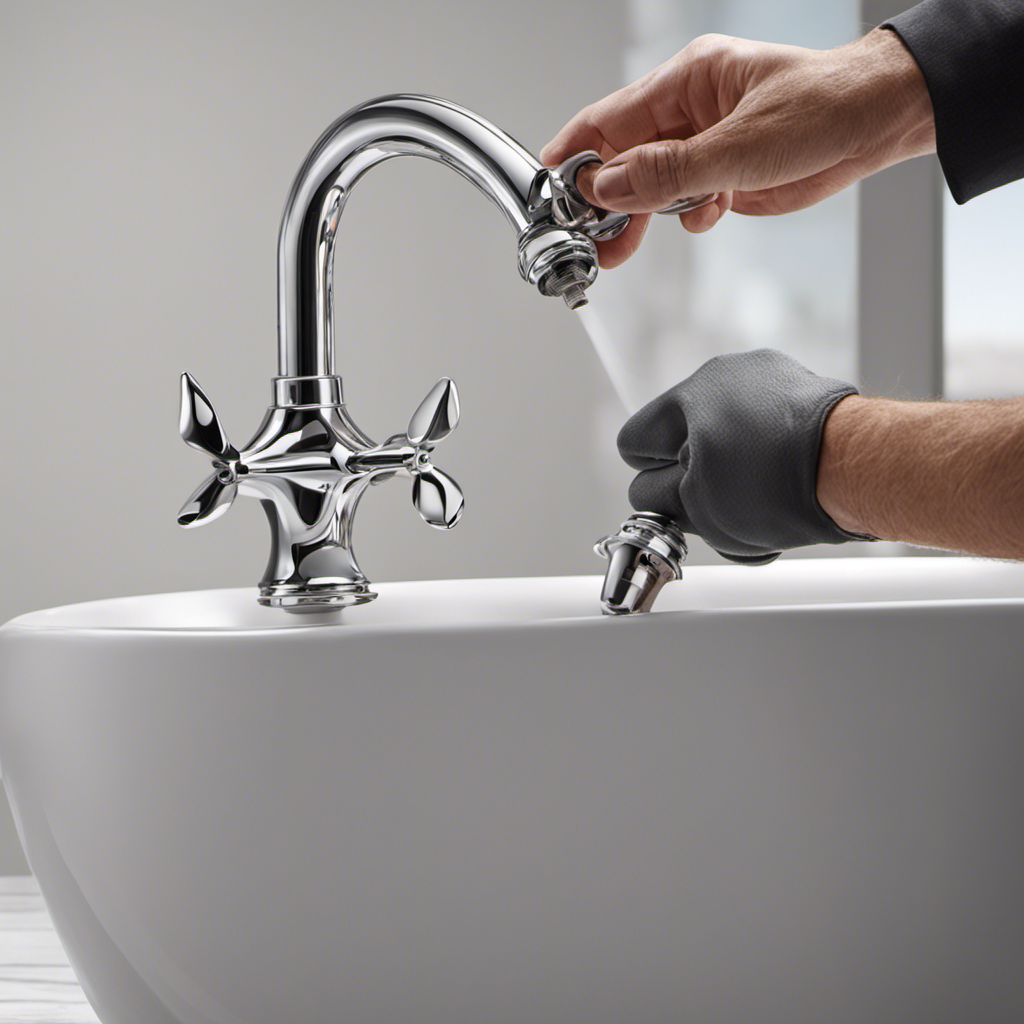I’ve always believed that a clean bathtub is like a sanctuary, a place where I can escape the chaos of everyday life and find solace. But achieving and maintaining that pristine state requires some effort and know-how.
In this article, I’ll share my tried and tested tips for keeping your bathtub sparkling clean. From choosing the right cleaning products to establishing a regular cleaning routine, I’ll cover everything you need to know to transform your bathtub into a haven of cleanliness and relaxation.
So let’s dive in and make your bathtub shine like never before!
Key Takeaways
- Use natural and eco-friendly cleaning products free from harsh chemicals.
- Establish a regular cleaning routine to maintain a clean and hygienic bathroom environment.
- Remove soap scum and hard water stains by using vinegar and wiping down the tub after each use.
- Prevent mold and mildew buildup by ensuring proper ventilation and using mold-killing cleaners.
Choosing the Right Cleaning Products
To keep your bathtub clean, you should make sure you’re choosing the right cleaning products. Using natural alternatives and eco-friendly options not only helps maintain a sparkling clean tub but also reduces the impact on the environment.
When selecting cleaning products, it is important to consider their ingredients. Look for products that are free from harsh chemicals such as chlorine, ammonia, and phosphates. Instead, opt for natural alternatives like vinegar, baking soda, and lemon juice. These ingredients are not only effective at removing dirt and grime but also safe to use.
Additionally, eco-friendly options such as plant-based cleaners and biodegradable soaps are becoming increasingly available. By choosing these products, you can keep your bathtub clean while promoting a healthier and more sustainable lifestyle.
Establishing a Regular Cleaning Routine
Make sure you establish a regular cleaning routine for your tub. This will help maintain a clean and hygienic bathroom environment.
Here’s a simple 4-step process to follow:
-
Gather the necessary cleaning tools: You’ll need a scrub brush, a non-abrasive cleaner, a sponge or cloth, and a bathroom cleaner for the fixtures.
-
Remove any debris: Before starting the cleaning process, make sure to remove any hair, soap scum, or other debris from the tub surface.
-
Apply the cleaner: Spray the non-abrasive cleaner onto the tub surface and let it sit for a few minutes to loosen any dirt or stains.
-
Scrub and rinse: Use the scrub brush or sponge to scrub the tub surface, paying attention to any problem areas. Rinse thoroughly with water to remove all traces of cleaner.
Removing Soap Scum and Hard Water Stains
Removing soap scum and hard water stains can be challenging, but there are effective methods to tackle these stubborn bathroom nuisances.
To remove hard water stains, I recommend using a mixture of vinegar and water. Simply spray the solution onto the affected areas, let it sit for a few minutes, and then scrub with a sponge or brush.
For soap scum buildup prevention, regularly wiping down your bathtub after each use can make a big difference. Additionally, using a squeegee to remove excess water and moisture can help prevent soap scum from forming.
Another tip is to switch to liquid soap instead of bar soap, as it tends to leave behind less residue.
Preventing Mold and Mildew Build-up
When it comes to preventing mold and mildew build-up, two key points to consider are proper ventilation and using the right cleaning techniques.
Ventilation plays a crucial role in mold prevention as it helps to keep the air circulating and reduce moisture levels in the environment. This can be achieved by opening windows, using exhaust fans, and ensuring that there is proper airflow in areas prone to mold growth.
Additionally, using the right cleaning techniques, such as using mold-killing cleaners and regularly scrubbing surfaces prone to mold growth, can help to effectively remove and prevent the growth of mold and mildew.
Ventilation for Mold Prevention
To prevent mold, you need to ensure proper ventilation in your bathroom. Adequate airflow is essential for maintaining a dry environment and controlling humidity levels. Here are four important steps to help you maintain proper ventilation and control bathroom humidity:
-
Install a bathroom exhaust fan: This helps remove excess moisture from the air, preventing it from condensing on surfaces and promoting mold growth.
-
Clean and maintain the exhaust fan regularly: Dust and debris can accumulate in the fan, reducing its efficiency. Clean the fan blades and vents regularly to ensure proper airflow.
-
Keep bathroom windows open: Opening windows during and after showers allows fresh air to circulate, reducing humidity levels and preventing mold formation.
-
Use a dehumidifier if necessary: If your bathroom has persistent humidity issues, consider using a dehumidifier to remove excess moisture from the air.
Proper Cleaning Techniques
Regularly cleaning your bathroom surfaces is essential for preventing mold growth and maintaining a healthy environment. When it comes to keeping your bathtub clean, there are a few proper cleaning techniques that can make a big difference.
First, gather your cleaning tools, such as a scrub brush, microfiber cloth, and a non-toxic cleaner. Opting for eco-friendly options not only helps protect the environment but also reduces exposure to harmful chemicals.
Start by wetting the bathtub and applying the cleaner, making sure to cover all areas. Use the scrub brush to gently scrub away any dirt or grime, paying extra attention to areas prone to soap scum buildup.
Rinse thoroughly to remove all residue and dry the surface with a microfiber cloth.
Maintaining the Drain and Plumbing
When it comes to maintaining the drain and plumbing in my home, I have found that regular drain cleaning methods are essential. By using methods such as using hot water, vinegar, and baking soda, I can effectively remove any buildup and prevent clogs from occurring.
Additionally, I have learned that preventing clogs and buildup is crucial in order to avoid costly repairs and ensure the proper functioning of my plumbing system.
Regular Drain Cleaning Methods
One way to keep a bathtub clean is by using a drain cleaner regularly. Regular drain cleaning is essential to prevent clogs and maintain proper drainage.
Here are four effective drain cleaning solutions that you can try:
-
Vinegar and Baking Soda: Mix equal parts vinegar and baking soda and pour it down the drain. Let it sit for 15-30 minutes before flushing it with hot water. This natural cleaning method helps remove grease and grime buildup.
-
Boiling Water: Boil a kettle of water and carefully pour it down the drain. The hot water helps dissolve and flush away any soap scum or debris.
-
Enzyme Drain Cleaner: These natural cleaners contain enzymes that break down organic matter in the drain. Follow the instructions on the product for best results.
-
Plunger: If you have a clog, a plunger can be a handy tool to dislodge it. Make sure to create a tight seal and plunge vigorously to clear the blockage.
Preventing Clogs and Buildup
Using natural drain cleaning solutions, such as vinegar and baking soda, can help prevent clogs and buildup in your bathtub. These solutions are not only effective but also safe for the environment.
When vinegar and baking soda are combined, they create a chemical reaction that helps break down organic materials and clear away any residue that may be causing clogs.
Additionally, using these natural solutions can also help prevent rust and corrosion in your bathtub. Rust stains can be unsightly and difficult to remove, but by regularly using vinegar and baking soda, you can effectively remove rust stains and keep your bathtub looking clean and shiny.
Simply mix equal parts vinegar and baking soda, apply the mixture to the rust stains, scrub gently with a sponge or brush, and rinse thoroughly.
Deep Cleaning Techniques for Stubborn Stains
To effectively remove stubborn stains in your bathtub, start by applying a mixture of vinegar and baking soda. This combination creates a powerful cleaning solution that is both natural and effective. Follow these steps for a thorough deep cleaning:
- Begin by dampening the stained area with water.
- Sprinkle a generous amount of baking soda over the stains.
- Pour vinegar onto the baking soda and watch as it fizzes and reacts.
- Use a scrub brush or sponge to gently scrub the mixture into the stains, working in circular motions.
The vinegar and baking soda mixture will help break down and lift the stubborn stains, while the scrubbing action will further assist in removing them. Rinse the area well with water and repeat if necessary.
This cleaning hack is a cost-effective and environmentally friendly solution for tackling tough bathtub stains.
Tips for Keeping Your Bathtub Sparkling Clean
Make sure you regularly scrub your tub with a mixture of vinegar and baking soda to maintain its sparkling appearance.
Bathtub maintenance is important to keep it clean and hygienic.
Natural cleaning solutions like vinegar and baking soda are effective in removing dirt, grime, and soap scum without the use of harsh chemicals.
To start, sprinkle baking soda on the surface of the tub and then spray vinegar over it.
Scrub the mixture with a brush or sponge, focusing on any stained or dirty areas.
Rinse with warm water and wipe dry with a clean cloth.
This simple routine not only keeps your bathtub looking pristine but also helps prevent the buildup of bacteria and mold.
Regular maintenance is key to keeping your bathtub clean and inviting for a relaxing bath.
Conclusion
In conclusion, keeping a bathtub clean is essential for maintaining a hygienic and inviting bathroom space.
By following the right cleaning routine and using effective products, you can easily remove soap scum, hard water stains, and prevent mold and mildew build-up.
Regular maintenance of the drain and plumbing ensures proper functioning, while deep cleaning techniques tackle stubborn stains.
With these tips, your bathtub will sparkle like a gem, inviting you to relax and unwind in its pristine waters.










